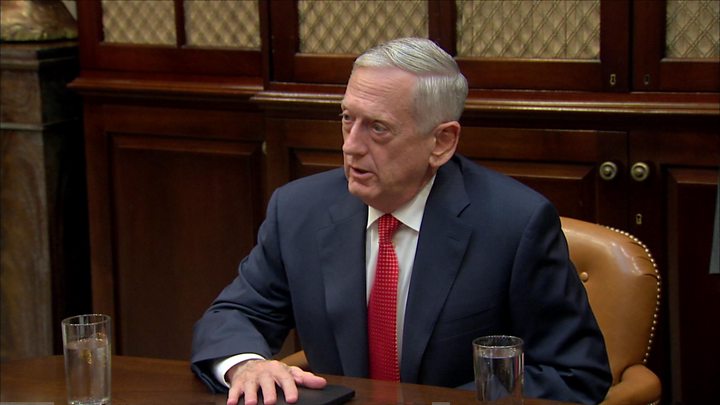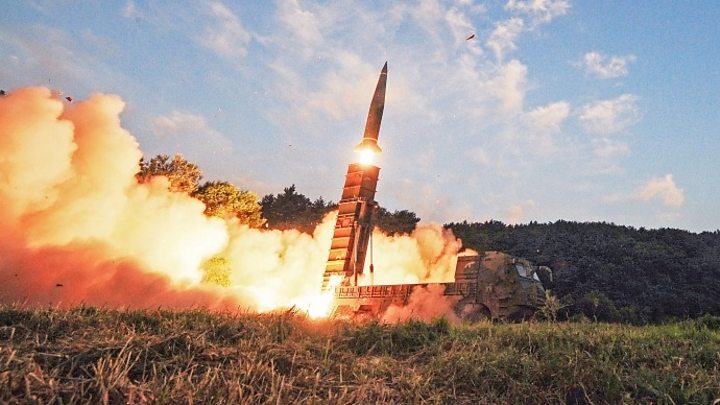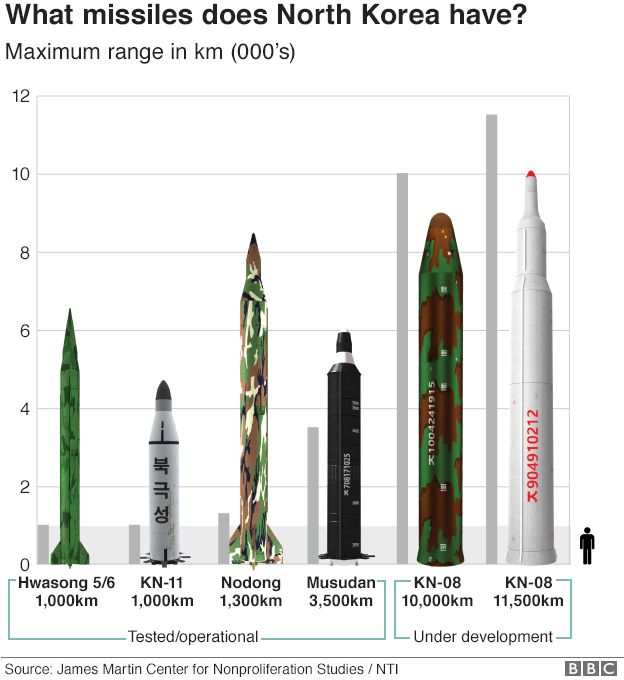
North Korea has fired its highest-ever intercontinental ballistic missile and poses a worldwide threat, US Secretary of Defence James Mattis has said.
The missile, launched early on Wednesday, landed in Japanese waters.
It reached an altitude of 4,500km (2,800 miles) and flew 960km, according to South Korea's military.
It was the latest in a series of weapons tests that has raised tensions. Pyongyang last launched a ballistic missile in September.
It also conducted its sixth nuclear test that month. North Korea has continued to develop its nuclear and missile programme despite global condemnation and sanctions.
The UN Security Council is due to convene an emergency session to discuss the latest test.
- What damage could North Korea do?
- Are missiles a risk to planes?
- Can the world live with a nuclear North Korea?
- North Korea's missile programme
Mr Mattis said the missile launch "went higher, frankly, than any previous shots they have taken".
The North was building "ballistic missiles that threaten everywhere in the world", he added.
US President Donald Trump was briefed while the missile was still in the air, the White House said. Afterwards he said: "We will take care of it."
The BBC's Rupert Wingfield-Hayes says estimates by Japanese and US experts suggest if fired on a normal trajectory this missile could have reached Washington DC.
That means North Korea is now very close to attaining its goal of an operational intercontinental ballistic missile that can strike anywhere in the mainland US, says our correspondent.

Wednesday's missile was launched from Pyongsong, in South Pyongan province, reported South Korean news agency Yonhap.
Japanese officials said the projectile travelled for about 50 minutes - but did not fly over Japan, as some have done in the past - and landed about 250km off its northern coast.
Japan also said it would "never accept North Korea's continuous provocative behaviour", while South Korea condemned the launch and responded with a missile exercise of its own.
The EU has called the launch a "further unacceptable violation" of North Korea's international obligations, while Britain's ambassador to the UN called it "a reckless act".

A problem without a solution
Jonathan Marcus, BBC Defence and Diplomatic Correspondent
This missile test, the first for some two months, suggests that the lull in firings was not due to North Korea being cowed by Mr Trump's rhetoric or even by Chinese pressure. Experts have indeed pointed to similar seasonal slowdowns in testing in the past.
President Trump, responding to the test, says that his administration will handle it. But handle it how ? The US has called for an urgent meeting of the UN Security Council. And Secretary of State Rex Tillerson has spoken of stepping up the pressure on Pyongyang.
But North Korea is already one of the most isolated and heavily sanctioned states in the world. There are few new levers to pull.
North Korea is seemingly a problem without a solution and its nuclear and missile programmes are now, once again, back at the top of the Trump administration's security agenda.

North Korea's last nuclear test reportedly involved a miniaturised hydrogen bomb that could be loaded onto a long-range missile.
Last week, Mr Trump announced that the US was re-designating North Korea a state sponsor of terrorism because of its missile and nuclear programme.
The US imposed fresh sanctions against Pyongyang. The measures targeted North Korean shipping operations and Chinese companies that traded with the North.


Major North Korean missile tests in 2017
North Korea has carried out numerous missile tests this year. Some of these exploded shortly after launch, but others travelled for hundreds of miles before landing in the sea. Here are some of the major tests reported so far:
12 February - A medium-range ballistic missile launched from Banghyon air base near the west coast. It flew east towards the Sea of Japan for about 500km.
5 April - A medium-range ballistic missile fired from the eastern port of Sinpo into the Sea of Japan. South Korea's defence ministry said the missile flew about 60km.
4 July - Pyongyang claimed to have successfully tested an intercontinental ballistic missile for the first time. Officials said it reached an altitude of 2,802km and flew for 39 minutes.
29 August - North Korea fired what is thought to be its first nuclear-weapon capable ballistic missile over Japan. It was launched from near Pyongyang and reached a height of about 550km.
15 September - A ballistic missile was fired across Japan for the second time and landed in the sea off Hokkaido. It reached an altitude of about 770km and travelled 3,700km.

- North Korea missile 'higher' than previous tests, says Mattis
- What damage could North Korea do even without nuclear weapons?
- What we know about North Korea's missile programme
- North Korea missile test splits world powers
- North Korea missile: How long has Japan got to defend itself?
- What are North Korea's other WMDs?

No comments:
Post a Comment